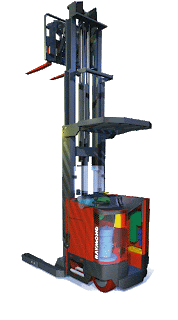Power
A 24-volt electrical system. Drive Unit/Drive Motor
The largest drive unit in its class of truck means long-term performance. Crown-built separately excited drive motor matches motor performance for the task. Drive Tire
The large drive tire (13") improves traction and stability
Four-Point Footprint
A drive tire, caster wheel and two load wheels provide a four-point footprint. Caster is adjustable to compensate for tire wear. Control Handle
Multiple-function control pod simplifies any task and is time-tested for proven reliability. The directional controls offer additional stability and confidence advantages. Our fixed (non-pivotal) directional control handle, coupled with four points of solid contact, adds another degree of security at height. Speed
Maximum travel speed: 7.0 mph Operator Safety & Comfort
Optimum control at higher elevations Brakes
Crown's patented Intelligent Braking System (IBS) uses motor-assisted braking combined with optimum amounts of friction braking. Visibility
The platform window offers the largest viewing area available for a clearer view of pick locations during forward travel. Serviceability
Faster, easier service is the result of an innovative system that simplifies service by providing the technician with convenient access to easy-to-comprehend, critical information about the truck. Raymond's' 5000 Series Order Picker  In addition to variable lift/lower control, ergonomic control handle, and auto locking pallet clamp, 5000 Series employs ACR System(TM) that minimizes battery changes and facilitates product movement. Model 5600 has ac drive and lift system and is available in 36 V configurations with elevated truck heights up to 366 in., while Model 5400 has ac drive, dc lift, and 366 in. elevated truck height. Model 5200 offer dc drive and lift systems and 241 in. elevated height.
Big Joe SSCM Order Picker/ Stock Picker
 Model SSCM Stock Selector allows user to lift, lower, forward, and reverse from stock picking level. All controls are located on elevating operator compartment and platform, allowing complete maneuverability. Maneuverable 32 in. wide unit is able to go into areas where only rolling ladders were previously used. Stock Selector is also suitable for overhead applications, such as changing lights and heater and sprinkler maintenance.

Horizontal Order Picker, Model ECE 20 has 24 V, 3-phase AC motor that allows max travel speed of 6.5 mph. Electronic controllers automatically regulates acceleration, travel speed, and braking according to operator preferences. Hydraulic lifting/lowering is provided by high-pressure pump with 2.0 kW motor. Fork lengths range from 39–94 in. and max load capacity is 5,000 lb. Steering options include mechanical tiller handle, electric tiller handle, and JET Pilot.
| 













 Turret Truck
Turret Truck








